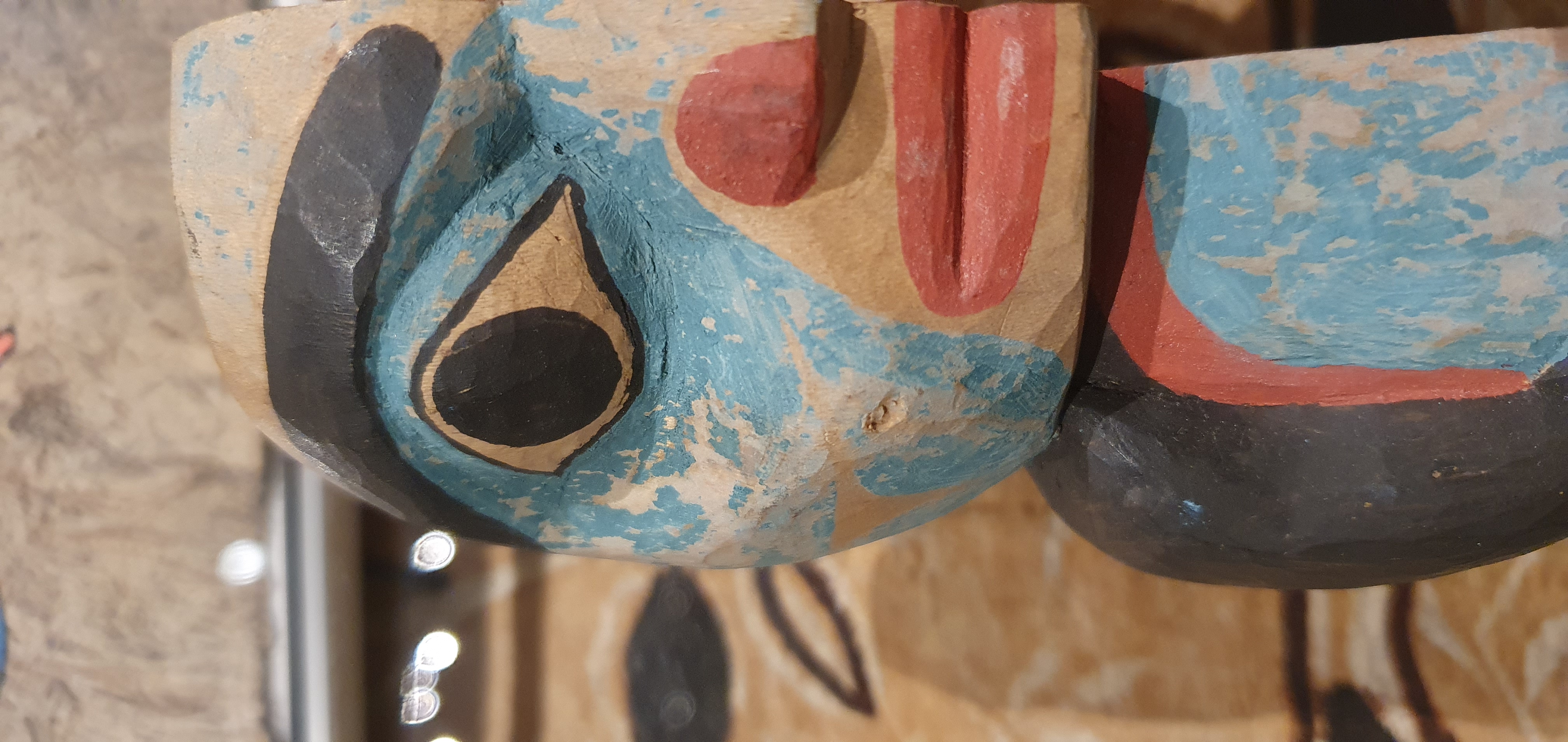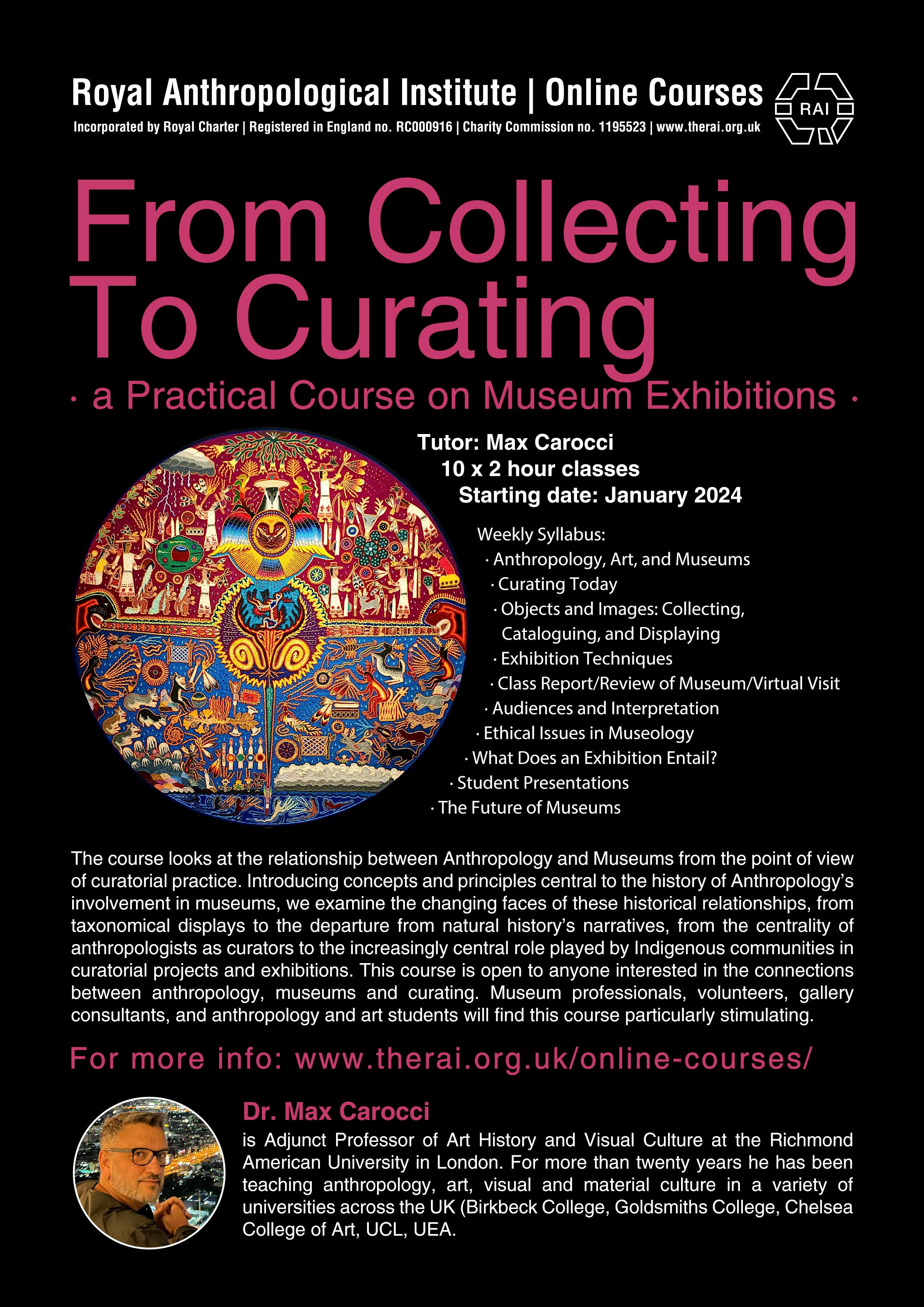Taught by Dr. Max Carocci
10 x 1. 5 hour classes
Start date: Spring 2024 (exact date TBC)
Price: £245
Please see our FAQ page or email courses@therai.org.uk with any questions.
This course is open to anyone interested in the connections between anthropology, museums and curating. Museum professionals, volunteers, gallery consultants, anthropology and art students will find this course particular stimulating.

The course looks at the relationship between Anthropology and Museums from the point of view of curatorial practice. Introducing central concepts and principles central to the history of Anthropology’s involvement in museums, we examine the changing faces of these historical relationships, from taxonomical displays, to the departure from natural history’s narratives, from the centrality of anthropologists as curators, to the increasingly central role played by source and Indigenous communities in curatorial projects and exhibitions.
Tutor biography
Dr. Max Carocci is Adjunct Professor of Art History and Visual Culture at the Richmond American University in London. For more than twenty years he has been teaching anthropology, art, visual and material culture in a variety of universities across the UK (Birkbeck College, Goldsmiths College, Chelsea College of Art, UCL, University of East Anglia). In addition to his academic career, he has served as curator at the British Museum, the Weltkulturen Museum Frankfurt, the Venice Biennale, and several institutions (including the RAI), and galleries in Britain and abroad. Max has published widely on a variety of subjects at the intersection of Anthropology and Art. Among his latest publications,Art, Observation, and an Anthropology of Illustration(co-edited with Stephanie Pratt, Bloomsbury, 2022), andArt, Shamanism and Animism(co-edited with Robert J. Wallis, MDPI: Basel, 2022).
https://www.linkedin.com/in/max-carocci-62a50b17/
https://richmond-uk.academia.edu/MaxCarocci
Course objective & structure:
We will examine the challenges presented by past and present case studies to build critical skills, and practical approaches to curating world art collections, archaeological material, ethnographic and folk objects, as well as contemporary arts from places usually associated with areas of anthropological remit. What is more, the course will offer an anthropological perspective on museums as sites of cultural encounter, mediation, and creation in the contemporary world.
Over the course of ten sessions, we will touch upon central issues in current museum practice from ethical issues in displays and cultural sensitivity, to religious pluralism and social inclusion, from community engagement and relationships with source communities, to fieldwork collecting, and collaborative methodologies, as well as the role of intangible heritage and performance in museums, among others.
A practical component complements the contextual elements of the programme, which is aimed at developing a set of guidelines for good practice in museums regardless of their character and nature.
By the end of the course, you should be able to:
- Discuss current museum issues and theories related to anthropology and curating
- Explain general curatorial principles and practices
- Entertain an independent assessment of museum techniques
- Use critical skills in museum ethnography and anthropology
- Compare and contrast Art Historical, Folk Art, World Cultures, Archaeological, and Ethnographic Museums
Summary of seminar topics:
- Week 1: Anthropology, Art, and Museums
- Week 2: Curating Today
- Week 3: Objects and Images: Collecting, Cataloguing, and Displaying
- Week 4: Exhibition Techniques
- Week 5: Class Report/Review of Museum/Virtual Visit
- Week 6: Audiences and Interpretation
- Week 7: Ethical Issues in Museology
- Week 8: What Does an Exhibition Entail?
- Week 9: Student Presentations
- Week 10: The Future of Museums
Further information about classes:
Week 1: Anthropology, Art, and Museums
Anthropology and museums have a long history that intertwines with local developments of the discipline. These different stories have resulted in a variety of approaches to collections that variably defined the role of the anthropologist in the museum, and constructed a multiplicity of museum typologies (e.g., ethnographic museums, folk art museums, world cultures museums, museums of archaeology, popular arts, and ethnology museums etc.). Here we outline some of the most salient differences between museums anthropologies in time and space to have a general overview of the field of inquiry entertained in this course.
Week 2: Curating Today
Purposes and types of exhibitions are diverse: educational, political, artistic. The presentation of collections to the public in museums is directly linked to the history of curating. In this session the history of display typologies is put in conversation with museum aims and character to reveal different priorities and curatorial strategies aimed at capturing a variety of audiences.
Week 3: Objects and Images: Collecting, Cataloguing, and Displaying
Museum collections are made up of a variety of different objects. These include items such as artifacts, photographs, visual expressions, memorabilia, religious objects, and sometimes, human remains. In this lesson we shall look at the processes through which an item becomes part of a collection. We will examine the trajectory of an object’s history from acquisition to display, passing through the cataloguing process, interpretation, and rationale for collecting.
Week 4: Exhibition Techniques
Museum adopt various techniques to convey their messages to the public. They may use reconstructions; dioramas; object displays; interactivity (e.g., media, databases, touch-screen, audio-visuals); educational/participatory interventions (e.g., demonstrations, tours, performances, storytelling; workshops). Invitation to visit a museum or exhibition that will be discussed in class.
Week 5: Class Report/Review of Museum/Virtual Visit
This week will host student presentations on the visit discussed in the previous week. It should include: analysis of content delivery, interpretation, and complementary material. It should also examine the use of space, objects lighting, forms of display, exhibition rationale, traffic flow, labelling, complementary material (e.g.; audiovisuals, interactive gadgets, three-D imaging etc.), interpretation, and educational programmes from selected case studies.
Week 6: Audiences and Interpretation
Who is the exhibition for? How do we engage different publics? How do museums come up with educational programmes, and all the components that complement them? This lesson is dedicated to activities central to museums’ education programmes, from workshops (hands-on), talks and conferences, to roundtables, guided tours, and performances.
Week 7: Ethical Issues in Museology
The increasingly more vocal criticisms moved against the politics of representation has encouraged museum practitioners and anthropologists to re-evaluate their ethical guidelines and principles. Here we look at the relationships with source communities, the delicate issue of displaying religious objects, how to deal with challenging collections (e.g., slavery, torture, inter-religious relations, restricted or secret material, etc.), and issues of repatriation of cultural property and human remains.
Week 8: What Does an Exhibition Entail?
How does one plan an exhibition? We will discuss the process and ways of thinking about an exhibition, from planning stages to design, mounting, interpreting, and marketing. You will be invited to produce a presentation where you discuss an idea for an exhibition for a known museum of which you can find a map. The following week you will present your pitch to the class, which will offer constructive criticism about your ideas. The tutor will act as facilitator.
Week 9: Student Presentations
Here you will present an exhibition proposal to the class in the form of a short PP that you can share with the other students. In it you will summarise: concept and rationale, aims and objectives, educational programme (e.g., talks, conference, guided tours, hands-on workshops, performances, demonstrations), marketing material (e.g., online presence, posters, catalogue, etc.), design (e.g.; possible use of audiovisuals, texts, and images, reconstructions, dioramas, mannequins, stands, interactive stations etc.), projected outcomes, and post exhibition material (catalogue, online information, new knowledge etc). Students will be encouraged to comment and ask questions about the project in order to strengthen individual proposals.
Week 10: The Future of Museums
Given the situation of today’s museums we can legitimately ask: What does the future of the Anthropology Museum look like? We shall evaluate how the museum is a creator of culture, and how it engenders moments of encounter and dialogue. Museums are however also places to store heritage, the inform the construction of identities, are educational tool. They are places of leisure and entertainment, but also sites of political activism. Is the future promising or challenging for these institutions? Will we see an increasing blurring of genres? Or the multidisciplinary, interdisciplinary cross-overs will decree the death of the Anthropology museum?
